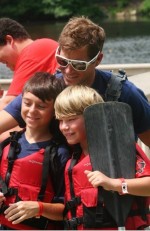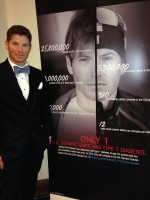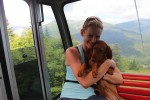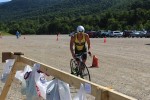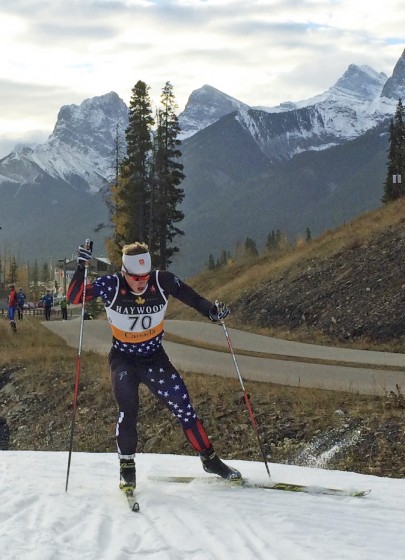
It’s been nine years since Kris Freeman last visited West Yellowstone, Mont. Back then, the New Hampshire native was 25 and one of the U.S. Ski Team’s best distance guys (along with Andrew Johnson, Carl Swenson and James Southam) destined for his second Olympics.
After the 2006 Torino Games and two more Olympics later, Freeman, 34, has returned to southern Montana, where he’s only been twice before: for the 2005 and 2002 SuperTour-opening races of the season.
Before that, Sovereign Lake — commonly known as Silver Star— in Vernon, British Columbia, was where many top Americans and Canadians converged at the start of each season in late November.
And every year since 2005, Freeman, a U.S. Ski Team (USST) member from 2002 to 2013, started each winter in Europe. So yeah, it’ll be a little weird for him to be back in West for this year’s opening SuperTour races, but he’s not complaining.
In a phone interview earlier this month from his home in Thornton, N.H., Freeman said he’s more settled this year since losing a major source of income and health benefits after the USST didn’t renominate him to the team in April 2013. In the months after, the Type-1 diabetic became a nordic-racing instructor at Waterville Valley, his original club, which provided health care and a financial boost in the months leading up to the 2014 Sochi Olympics.
Freeman, a 16-time national champion, went on to make the U.S. Olympic team as a non-USST member, placing third at U.S. nationals in the 15-kilometer classic as well as the 30 k freestyle mass start, and fourth in the classic sprint. In Sochi, Russia, he consistently placed around 50th: 52nd in the 15 k classic, 53rd in the skiathlon and 57th in the 50 k freestyle mass start.
It wasn’t anywhere close to the Olympic performance he was looking for, and Freeman ended the season then and there, returning home for two minor surgeries: to remove a viral infection from his right heel and undergo a gum-grafting procedure (in which tissue from the roof of his mouth was used to fill in three areas along his gum line).
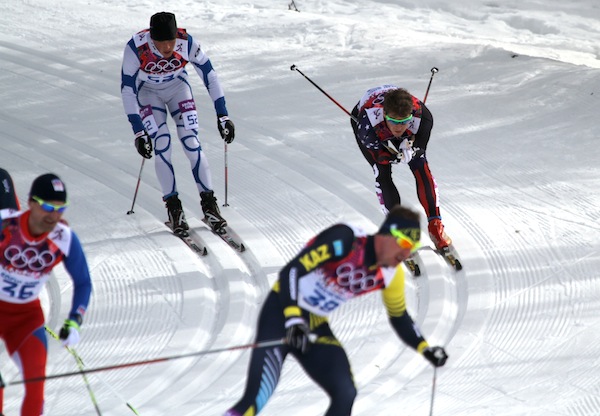
He scheduled the procedures in advance for the week he got back from Russia, tackling the foot first then seeing the oral surgeon the next day. For the next three weeks, he was out of commission, but that was OK — and by design. He spent the better part of the next three months taking a breather from nordic skiing.
“After the Olympics, my body was completely trashed,” Freeman said. “Part of the interesting thing about having diabetes is when things go bad, they go really bad for me really fast, and I go really deep into what appears to be a deep training hole. … I took three months of basically whatever I wanted to do which consisted of mostly telemark skiing and playing. By late June, I was back and my body was feeling the way it was used to.”
Because of his diabetes, he explained he’s more prone to chronic fatigue, which, in non-diabetic athletes, is caused by overly intense training and racing.
“Once the body’s reserves are used up it will begin to run on adrenaline whenever a stress is placed on it,” he explained. “This is not sustainable and eventually the adrenal gland will get tapped out. When this happens an athlete is diagnosable with chronic fatigue.”
When his blood sugar drops below normal, Freeman explained his body tries to keep those levels in check by releasing adrenaline, which tells the liver to dump sugar into the bloodstream. Since racing and interval training use a lot of adrenaline, a hard race schedule combined with frequent and severe blood-sugar lows could send him spiraling into chronic fatigue.
That’s what happened last season.
“Things just started out at not a very high level … and went downhill from there,” he said. “Last year was one of my hardest training years ever. I was absolutely flying in August and September, which is not when you want to be [at your fastest]. … I’m 34 now. I don’t respond to training the way I used to when I was 24. This year, we [myself and coach Zach Caldwell] took a much more conservative approach, especially after those three months of super easy.”
For each of the last four or five years, Freeman estimated he’d logged about 900 training hours. This training season, he figured he was closer to 700 or 800.
“When I look back at the overtraining or whatever you want to call it, the mistiming of fitness, the mistakes I made, I thought I was kind of immune from being cut from the USST,” he recalled. But he realized it had a bigger impact on his life than he anticipated.
“It was the only support system I knew. Going and changing everything in an Olympic year is difficult,” he said. “I’m still being supported by Waterville. I’m an employee there and I will be teaching some ski lessons this winter. I’m happy with that natural fit. My sponsors have stepped up for another year of support. The big change is I’m no longer with the Maine Winter Sports Center. I’ve chosen to be independent. I’m more comfortable to be at home; that’s where I’ve always made my biggest gains.”
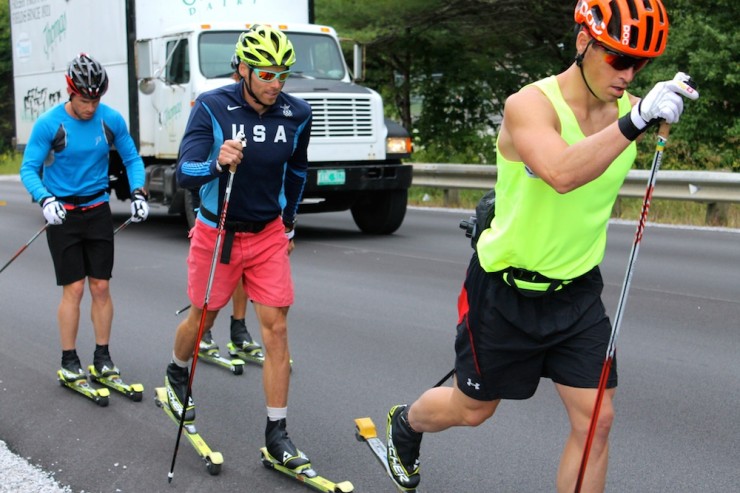
After revving up his training season with the Canadian World Cup Team and a couple USST men (Andy Newell and Simi Hamilton) in August in Stratton, Vt., Freeman went on to participate in the informal season-opener in Canmore, Alberta, racing both the classic sprint and 10.8 k freestyle race at Frozen Thunder. There, he placed second in the distance race and fourth in the sprint.
“I had what was probably my best sprint qualifier ever there — that was pretty fun,” Freeman said of his fourth-fastest qualifying time. “The skate race, I felt in control with good snap and good power. I would say both those race were far better than anything I put out last year.”
This season, Freeman, who raced in Canmore under the club name Freebird and is backed by equipment sponsors Swix and Fischer (he switched to their boots this year), will start the season in Montana, racing both the West Yellowstone opener and Bozeman SuperTour next weekend. Then, he’ll head north to the Canadian NorAm opener Dec. 13-14 in Rossland, British Columbia, followed by Whistler (Dec. 20-21), return to Thornton for Christmas, and head to Houghton, Mich., after New Year’s for U.S. nationals.
“I’m hoping at that point to be leading the SuperTour, in which case I’ll [earn World Cup starts in Rybinsk,] Russia,” he said.
But he doesn’t plan to go to Russia because it’s 13 time zones and a week after nationals.
“If all goes well, my first World Cup will be in Östersund, Sweden [Feb. 14-15],” he said. “I hope to make the World Championship team and finish out the season on the World Cup.”
While he’d like to see how he stacks up at this point on the World Cup, Freeman said going to Europe later could be a good thing. In the past, he struggled at times in February and March.
“I’d rather go over and hit it at World Championships than hit it in Kuusamo,” he said.
As for the 2018 Olympics in PyeongChang, South Korea, Freeman said he still “very much” enjoys skiing and tracking the adaptations in his body to build a perfect season. “I would love to complete in my fifth Olympics,” he said. “I’m going to take it year by year at this point.”
Same Story, Stronger Message
After two seasons with the Maine Winter Sports Center (MWSC) in the northeastern tip of Maine — about a 6 1/2-hour drive from Thornton in central New Hampshire, Freeman decided to return to his longtime base near Waterville Valley and cut down on travel during training blocks.
When he wasn’t pounding the pavement on rollerskis or running trails around Waterville, he could often be found touring a multitude of states around the country, speaking on behalf of Lilly Diabetes. Freeman’s been an ambassador with Lilly since just before the 2002 Olympics.
“When I first started working with Lilly, I used to spend more time going to diabetes expos where I’d sit at a booth and introduce myself,” he explained. “But we weren’t really targeting the people that could relate and maybe draw inspiration from my story.
“I always enjoyed working with kids far more than working with adults,” he continued. “I didn’t grow up with the disease as a lot of these kids have so I’ve learned a lot more. You get exposed to the challenges they’ve had: changing hormones, social interactions can be difficult, also at the very young ages, something as simple as sleeping over at somebody else’s house can be difficult because parents have no idea how to care to somebody with diabetes…”
For the last 10 years, Freeman has taken part in about six to 10 camps every summer, visiting more than 10,000 Type-1 campers and traveling more than 120,000 miles, according to Lilly.
He tries not to keep track.
“Each year, hundreds of camps will request I go there,” he said. Typically, he’ll give precedence to the places he hasn’t been before and lets Lilly do all the scheduling around his training plan.
This year, he dedicated two weeks to presenting, appeared at five camps in a week and made stops in “Indiana, Texas, Arkansas, California, New York… it becomes a little bit of a blur,” he said.
In May, he was a featured speaker at Juvenile Diabetes Research Foundation (JDRF) educational conferences in Phoenix, Detroit, and Albany, N.Y.
“Some people in the ski community might find it ironic, I actually kind of serve as a motivational speaker and I do have a rather blunt style of telling my story,” he said. “But at the same time it’s a very honest way of telling my story and people react to it and that’s why I do it.”
“Some people in the ski community might find it ironic, I actually kind of serve as a motivational speaker and I do have a rather blunt style of telling my story.” — Kris Freeman, Lilly Camp Care ambassador and four-time Olympian who was diagnosed with Type 1 diabetes at 19
Lilly has been his headgear sponsor since 2001, and while the nonprofit pays him to help with his racing, he said it’s about more than the money.
“I could continue to ski race without them, [but] it’s a lot easier to ski race with them,” he said. “They’re a part of my income for sure. I’m glad that I have a company that I respect.”
(Provided by Freeman, from one of his interviews this summer. “I found with kids that grow up with diabetes, they mature more quickly,” he said.)
- What has been your highest and lowest BG, and how did you deal with it?
- What is it about cross-country skiing that you like?
- What’s your favorite low-carb snack?
- What’s your favorite all-time Guns N’ Roses song (‘Welcome to the Jungle’ would be my answer)?
Over the years, Freeman’s message has generally stayed the same. He tells kids ages 6 to 18 that they can achieve anything they set their minds to — whether it involves sports, music, academics or anything else — and not to listen to anyone who tells them their diabetes will prevent them from doing so.
The first two doctors he had when he was diagnosed with Type-1 diabetes as a 19-year-old USST member said he wouldn’t compete at the next Olympics.
“I tell the kids this so that if somebody tells them they can’t do something, they can do it — they need to find a doctor that can work with them,” he said. “Their eyes open a little bit more. … A lot of the adults in their lives tell them they can’t do things because they’re nervous about them hurting themselves. [It’s about] educating the people around them about what this is and means.”
Since he’s become more comfortable with speaking in front of anywhere from 10 to 100 people at a time (although he still gets nervous presenting to 6 year olds: “It’s a little bit different keeping their attention,” he said), Freeman has opened up and shared more of his personal story as well.
“I tell them about the first time I went to the World Cup and it came time to take an injection of insulin,” he said. “I was like, ‘What am I going to do here? Go into the corner and be sneaky like I’m doping or something, or am I going to sit here at the lunch table and do it like I would at home?’ ”
He sat at the table and injected himself, and while it drew some looks, his fellow competitors eventually got used to it.
“I tell them to be open with it, about it, and I also tell them about the ideas of limitations of diabetes are outdated at this point because of the advances in insulin … and the way we can detect glucose,” Freeman added.
“In my early presentations, I would gloss over any difficulties I had. I wouldn’t talk about any lows … I wouldn’t talk about getting in the van after a workout being absolutely dehydrated, out of fuel and watch all [my] teammates pull out a quart of Gatorade and just down it, like, oh my God, that is something I wish I could do.”
He also frequently brings up what he considers one of the lowest points of his racing career: when he didn’t finish the 50 k classic at the 2010 Vancouver Olympics.
“I’ve had two lows in my career and one of them came in the biggest ski races of my life,” he said. “I share this crushing story and it makes me very relatable and it makes me seem real to them. I didn’t stop after that race and I came back after that season. … It’s a story of resilience, and if they can draw from that it makes it worth it. Honestly, the kids I talk to think 52nd at the Olympics was pretty awesome so it gives me perspective.”
When he gets back to training after a couple weeks on the road each summer, Freeman said he’s more focused. That’s what five to six hours a day at a diabetes camp, speaking and conversing and playing kickball and climbing on a ropes course with kids, does for him.
“When I take time away from training, it is important and I think more important in the grand scheme of things than skiing ever might be,” Freeman said. “I’m as guilty as ever as letting skiing be all-consuming …. I’ve gotten better at it over the years.”
At home, Freeman spends time with his girlfriend Amber Dodge and new puppy, She-Ra.
“The puppy is doing great — she’s gotten big enough that I can run with her now,” Freeman said of the seven-month-old, 40-pound Vizsla named after the sister of the comic-book character, He-Man.
This summer, he competed in a number of cross-training events, like the Wildman Biathlon, Top Notch and Josh Billings triathlons, US National Mountain Running Championships, and Mount Washington Road Race.
Fifteenth overall in Mount Washington’s 7.6-mile uphill run after his brother Justin in ninth, Freeman said he felt “pretty drained” and couldn’t get his heart rate above 164 during the June race. In a recent time trial, he was back to normal at 179.
This training season, he and Caldwell have measured his recovery using Galanes Sports Systems’ Firstbeat technology, which detects variability in Freeman’s heart rate while sleeping. From there, they’ve been able to determine how stressed his body is from training as well as measure the effects of his workouts.
“As time has gone on, I felt better and better,” Freeman said. “The time trials I did out in Park City with the Canadians … and in Canmore felt even better. Things are going in the right direction right now.”
Alex Kochon
Alex Kochon (alexkochon@gmail.com) is a former FasterSkier editor and roving reporter who never really lost touch with the nordic scene. A freelance writer, editor, and outdoor-loving mom of two, she lives in northeastern New York and enjoys adventuring in the Adirondacks. She shares her passion for sports and recreation as the co-founder of "Ride On! Mountain Bike Trail Guide" and a sales and content contributor at Curated.com. When she's not skiing or chasing her kids around, Alex assists authors as a production and marketing coordinator for iPub Global Connection.

